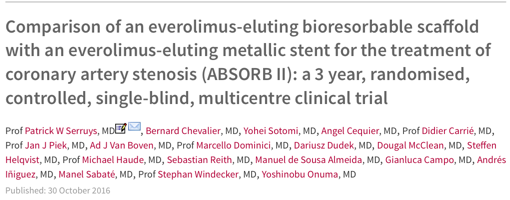The theoretical advantages of the fully bioresorbable scaffolds (BRSs) include, to begin, with the ability to dissolve after some months, restoration of vasomotion of the coronary artery, improbability of late stent thrombosis because of absence of a pro-inflammatory polymer, no hindrance during future MRI or other imaging, and avoiding jailing of a side branch.
However studies have suggested adverse effects with the BRS such as greater vessel thrombosis than contemporary drug eluting metallic stents (DES). Now the ABSORB II (Lancet October 2016) study involving 501 patients randomized in a 2:1 ratio to an everolimus eluting metallic stent (EES) reports its 3-year follow-up.
There was no difference in vasomotor reactivity, analyzed in 388 paired lesions. The treatment groups did not differ in mean lumen diameter after intracoronary nitrate administration (BRS 0.047 mm: EES 0.056 mm). Other endpoints favored EES significantly, including late lumen loss (BRS, 0.37 mm vs. EES 0.25 mm) and in-segment restenosis rate (8.4% vs. 3.3%). Target vessel revascularization rates were however similar. Myocardial infarction was higher with BRS than EES (8% vs. 3%). Half of these infarctions were periprocedural.
Late thrombosis occurred in 6 patients in the BRS group while no patient with EES developed stent thrombosis (p=0.03).
At 3 years follow-up BRS failed to demonstrate superior vasomotor tone and was associated with more late lumen loss, more thrombosis, greater incidence of myocardial infarction. Outcomes with BRS could be improved by better vessel preparation, use of IVUS or optical coherence tomography, post BRS dilatation, and appropriate vessel selection.
The ABSORB II was a prospective, randomized, single blind, multi-center trial. The researchers concluded that the trial did not meet its co-primary endpoints of superior vasomotor reactivity and non-inferior late luminal loss for BRS with respect to the metallic stent. The patient oriented composite endpoint, angina status, and exercise testing, were not statistically different between both devices at 3 years. Studies are required in future to investigate the clinical impact of accurate IVUS in sizing the device and optimizing the scaffold implantation.
The 2-year results of the ABSORB-China trial (presented in TCT 2016), which enrolled more than 400 patients, also suggested no significant difference between the same 2 devices for a clinical composite endpoint and, separately, target vessel failure. The follow-up rates were 98.5% at 1 year and 96.3% at 2 years. No significant differences were seen between the Absorb and Xience stents for patient oriented composite endpoint of all cause death, any myocardial infarction, or any revascularization (10% vs. 11.4%). The rate of cardiac death was low in both groups and not significantly different (0.4% vs. 1.3%) as was the rate of target vessel myocardial infarction (2% vs. 0.8%)
